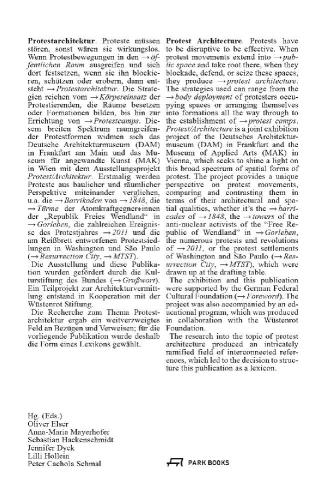
Protestarchitektur
Barrikaden, Camps, raumgreifende Taktiken 1830-2023 = Protest architecture : barricades, camps, spatial tactics 1830-2023
| Autor | |
| Quelle | Sonstige Datenquellen |
| ISBN | 978-3-03860-334-4 |
| Lieferbarkeit | lieferbar |
| Katalogisat | Basiskatalogisat |
| Verlag | Park Books |
| Erscheinungsdatum | 14.09.2023 |
Beschreibung (Kurztext)
176 Lexikoneinträge und 13 ausführlichen Fallbeispiele zur Protestarchitektur aus zwei Jahrhunderten: Resurrection City, Washington DC (USA, 1968); Republik Freies Wendland, Gorleben (Deutschland, 1980); Hüttendorf Startbahn West, Frankfurt am Main (Deutschland, 1980); Movimiento 15-M / Indignados-Bewegung, Puerta del Sol, Madrid (Spanien, 2011); Occupy Wall Street, Zuccotti Park, New York (USA, 2011); Tahrir Square, Revolution des 25. Januar / Arabischer Frühling, Kairo (Ägypten, 2011); Euromaidan, Kiew (Ukraine, 2013); Umbrella Movement, Hong Kong (China, 2014); MTST, São Paulo (Brasilien, 2017); Hambacher Forst (Deutschland, 2018); Demokratiebewegung, Hong Kong (China, 2019); Lobau, Wien (Österreich, 2021); Lützerath (Deutschland, 2022).
176 encyclopedia entries and 13 case studies of protest architecture over more than 190 years, from the 1830 July Revolution in Paris to the 2022 Freedom Convoy in Ottawa
Beschreibung (Langtext)
Protestbewegungen prägen den öffentlichen Raum nicht nur durch ihre Botschaften, sondern in vielen Fällen auch durch ihre – meist temporären – Bauten. Dieser These gehen das Deutsche Architekturmuseum DAM in Frankfurt und das MAK – Museum für angewandte Kunst in Wien in einem Ausstellungsprojekt nach, das von der deutschen Kulturstiftung des Bundes gefördert wird. Verhandelt wird das Thema anhand zahlreicher Beispiele aus den letzten rund 170 Jahren. Erstmals werden hierbei verschiedene Protestformen aus baulicher Perspektive systematisch miteinander verglichen, u. a. die Barrikaden der Revolution von 1848, die Pfahlbauten der Anti-Atomkraft- Bewegung in Gorleben (1980), die Zeltstädte des Arabischen Frühlings (2011), die Baumhäuser im Hambacher und im Dannenröder Forst (2018/19) oder auch die fluiden, Laser-basierten Lichträume der Demonstrierenden in Hongkong (2019).
Protestarchitektur,
konzipiert als Lexikon mit 176 Einträgen und 13 auführlicheren Fallbeispielen, ist die erstmalige internationale Bestandsaufnahme zur Architektur des Protests und präsentiert diese in all ihrer Vielseitigkeit und bisweilen auch Ambivalenz. Die vorangestellte Chronologie porträtiert 68 Protestbewegungen und ihre architektonischen Manifestationen auf je einer Seite und mit einer Abbildung.
Protest movements shape public space not only through their messages, but in many cases also through their—mostly temporary—buildings. Frankfurt’s Deutsches Architekturmuseum DAM and Vienna’s MAK—Museum of Applied Arts are exploring this thesis in a joint exhibition project. The exhibition and the book coinciding with it explore the topic based on examples spanning from 1830 to 2022.
Protest Architecture
is the first-ever international survey of the architecture of protest and presents it in all its manifold forms and, in some cases, ambivalence. It is conceived as an encyclopedia with 176 entries, supplemented by 13 more expansive case studies. A preceding chronology portrays 68 protest movements and their architectural manifestations through concise texts and one image each, including examples from all over the world, such as the 1830 July Revolution in Paris, the 1848 March Revolution in Berlin, the 1911 Sugar Workers Strike in Queensland (Australia), the 1936–37 General Motors Sit-down Strike in Flint, MI (USA), the 1969–98 Troubles in Northern Ireland, Freetown Christiania in Copenhagen since 1971, the 1986 People Power Revolution in Manila, the 1999 WTO Protests in Seattle, WA (USA), the 2011 Arab Spring revolutions on Cairo’s Tahrir Square and Manama’s Pearl Roundabout, the 2013–14 Euromaidan uprisings in Kyiv, the 2015–16 #FeesMustFall student protests in Pretoria, the 2019 Acampamento Terra Livre in Brasilia, the 2020–21 Indian Farmers Protests, and the 2022 Freedom Convoy in Ottawa.




